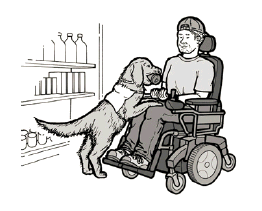Service Animals
Often businesses such as stores, restaurants, hotels, or theaters have policies that can exclude people with disabilities. For example, a “no pets” policy may result in staff excluding people with disabilities who use dogs as service animals. A clear policy permitting service animals can help ensure that staff are aware of their obligation to allow access to customers using service animals. Under the ADA’s revised regulations, the definition of “service animal” is limited to a dog that is individually trained to do work or perform tasks for an individual with a disability. The task(s) performed by the dog must be directly related to the person’s disability. For example, many people who are blind or have low vision use dogs to guide and assist them with orientation. Many individuals who are deaf use dogs to alert them to sounds. People with mobility disabilities often use dogs to pull their wheelchairs or retrieve items. People with epilepsy may use a dog to warn them of an imminent seizure, and individuals with psychiatric disabilities may use a dog to remind them to take medication. Service members returning from war with new disabilities are increasingly using service animals to assist them with activities of daily living as they reenter civilian life. Under the ADA, “comfort,” “therapy,” or “emotional support” animals do not meet the definition of a service animal.

Service animals provide many types of assistance for people with disabilities.
Under the ADA, service animals must be harnessed, leashed, or tethered, unless these devices interfere with the service animal’s work or the individual’s disability prevents him from using these devices. Individuals who cannot use such devices must maintain control of the animal through voice, signal, or other effective controls. Businesses may exclude service animals only if 1) the dog is out of control and the handler cannot or does not regain control; or 2) the dog is not housebroken. If a service animal is excluded, the individual must be allowed to enter the business without the service animal.
In situations where it is not apparent that the dog is a service animal, a business may ask only two questions: 1) is the animal required because of a disability and 2) what work or task has the animal been trained to perform? No other inquiries about an individual’s disability or the dog are permitted. Businesses cannot require proof of certification or medical documentation as a condition for entry [sic]

User Comments/Questions
Add Comment/Question